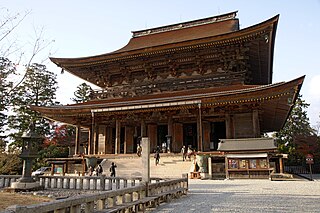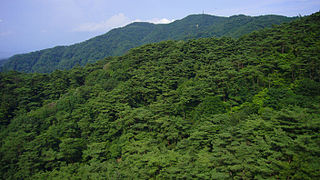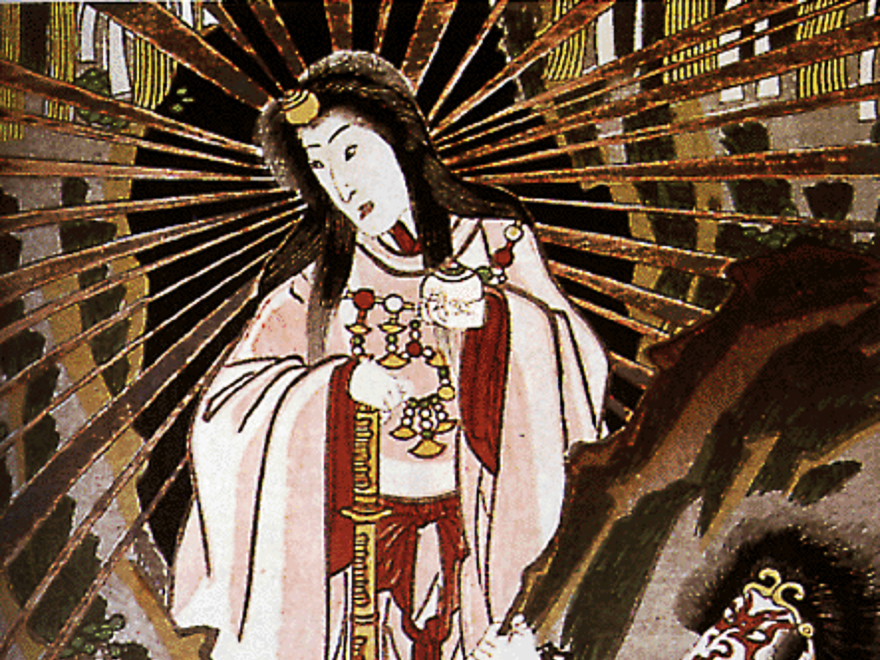 W
WShugendō is a highly syncretic religion, a body of ascetic practices that originated in Heian-era Japan, having evolved during the 7th century from an amalgamation of beliefs, philosophies, doctrines and ritual systems drawn from local folk-religious practices, Shinto mountain worship and Buddhism. The final purpose of Shugendō is for practitioners to find supernatural power and save themselves and the masses by conducting religious training while treading through steep mountain ranges. Practitioners are called Shugenja or Yamabushi . The mountains where shugenja practiced were all over Japan, and include various mountains of the Ōmine mountain range such as Mount Hakkyō and Mount Ōmine.
 W
WDaigo-ji is a Shingon Buddhist temple in Fushimi-ku, Kyoto, Japan. Its main devotion (honzon) is Yakushi. Daigo, literally "ghee", is used figuratively to mean "crème de la crème" and is a metaphor of the most profound part of Buddhist thoughts.
 W
WDaisen-ji is a Buddhist temple in the town of Daisen, Tottori, Japan. The temple is built on the slopes of Daisen. The Amida-dō and other parts of the temple are designated National Treasures of Japan.
 W
WA gongen (権現), literally "incarnation", was believed to be the manifestation of a buddha in the form of an indigenous kami, an entity who had come to guide the people to salvation, during the era of shinbutsu-shūgō in premodern Japan. The words gonge (権化) and kegen (化現) are synonyms for gongen. Gongen shinkō (権現信仰) is the term for belief in the existence of gongen.
 W
WMount Haku , or Mount Hakusan, is a dormant stratovolcano in Japan. It is located on the borders of Gifu and Ishikawa, on the island of Honshu. Mount Haku is thought to have first been active 300,000 to 400,000 years ago, with the most recent eruption occurring in 1659. Along with Mount Tate and Mount Fuji, it is one of Japan's "Three Holy Mountains" .
 W
WHeisenji Hakusan Shrine is a Shinto shrine in the city of Katsuyama, Fukui Prefecture, Japan. In the former Modern system of ranked Shinto Shrines, it was a prefectural shrine of Fukui Prefecture. Noted for its mossy gardens, the shrine gardens were designated a National Place of Scenic Beauty (名勝) in 1930 and a National Historic Site of Japan in 1935. Its main festival is held annually on April 20. The area of the shrine is within the boundaries of Hakusan National Park.
 W
WHikosan Jingū (英彦山神宮) is a Shinto shrine located in Soeda, Fukuoka prefecture, Japan. Located on the boundary between Fukuoka and Oita Prefectures, Hiko-san has been venerated from ancient times as a sacred mountain. It was also a center of training for the Shugendō sect of Buddhism. The shrine is located on the Fukuoka Prefecture side of the mountain. The Jō-gu is located in the innermost part of the shrine grounds on the top of Naka-dake, the center peak of the three Hiko-san peaks. The sanctuary is said to have been built in 740. The Hōhei-den, a large lecture hall built in 1616, and the Kane-no-Torii, a bronze Shinto gateway built in 1637, have both been designated Important Cultural Properties by the Japanese government.
 W
WIn the Vedic Hinduism, a homa also known as havan, is a fire ritual performed on special occasions by a Hindu priest usually for a homeowner. The grihasth keeps different kinds of fire including one to cook food, heat his home, amongst other uses; therefore, a Yajna offering is made directly into the fire. A homa is sometimes called a "sacrifice ritual" because the fire destroys the offering, but a homa is more accurately a "votive ritual". The fire is the agent, and the offerings include those that are material and symbolic such as grains, ghee, milk, incense and seeds.
 W
WHōten-ryū (法典流) is a Japanese martial art founded in 1600 CE. It is a school founded on the use of the sword, however it has several different kobuki in its curriculum. It is also notable for its hidden weapons or items that appear to hide among everyday things.
 W
WKinpusen-ji is the head temple of a branch of the Shugendō religion called Kinpusen-Shugendō in Yoshino district, Nara Prefecture, Japan. According to tradition, it was founded by En no Gyōja, who propagated a form of mountain asceticism drawing from Shinto and Buddhist beliefs. Along with Ōminesan-ji Temple, it is considered the most important temple in Shugendō.
 W
WMount Kongō is a 1,125-metre-high (3,691 ft) mountain in the Kawachi region of Osaka Prefecture, Kansai, Japan. It is near Mount Yamato Katsuragi.
 W
WMount Atago is a very common name for peaks all over Japan.
 W
WMount Maya is a 698.6-metre-high (2,292 ft) mountain in Kobe, Hyōgo Prefecture, Japan. This mountain is one of the major peaks of the Rokkō Mountains, and is the most popular peak for visitors on the West-Rokkō Mountains.
 W
WMount Rokkō is the name of a range of mountains in southeastern Hyōgo Prefecture, Japan.
 W
WMount Sekidō is a 564 metres (1,850 ft) mountain on the border of Nanao and Nakanoto in Ishikawa Prefecture and the town of Himi, in Toyama Prefecture. It is also called Mount Isurugi . Mount Sekidō was considered a holy mountain and was the center of a mountain cult since the Heian period. It was designated a National Historic Site of Japan in 1978. It is located with the borders of the Noto Hantō Quasi-National Park.
 W
WMount Togakushi is located in Togakushi, Nagano, Nagano, Japan. It is 1904 meters high.
 W
WNisseki-ji (日石寺) is a Buddhist temple in the town of Kamiichi, Toyama Prefecture, Japan. The temple belongs to the Shingon sect of Japanese Buddhism. It is more popularly known by the name of Ōiwa Fudō (大岩不動) after its main image.
 W
WThe Ōmine Okugakemichi is a pilgrimage route on the Kii Peninsula in the Kansai region of Japan. It begins in Yanagi-no-shuku, a former ferry station on the Yoshino River in Nara prefecture, leads through the 1200-1900 meter Ōmine mountain region of Yoshino and Kumano in Wakayama Prefecture and ends after about 170 kilometers at the Kumano Hongū Taisha.
 W
WMount Ōmine , is a sacred mountain in Nara, Japan, famous for its three tests of courage.
 W
WŌminesan-ji is an important temple of the Shugendō religion in Yoshino district, Nara prefecture, Japan. It is located at the peak of Mount Ōmine, or Sanjōgatake. According to tradition, it was founded by En no Ozunu, the founder of Shugendō, a form of mountain asceticism drawing from Buddhist and Shinto beliefs. Along with Kinpusen-ji Temple, it is considered the most important temple in Shugendō.
 W
WSaruka Jinja (猿賀神社), sometimes rendered Saruga, is a Shinto shrine in Hirakawa, Aomori Prefecture, Japan. The shrine is said to have been founded in 807, when Sakanoue no Tamuramaro came north during the campaigns against the Ezo. The Honden, dating to 1826, is a Prefecturally-designated Important Cultural Property. Preserved building records (棟札) are a City-designated Important Cultural Property. There is an annual rice-planting festival and a pond of pink lotus. The main kami enshrined here is Kamitsukenokimitaji no mikoto (上毛野君田道命).
 W
WSokushinbutsu are a kind of Buddhist mummy. The term refers to the practice of Buddhist monks observing asceticism to the point of death and entering mummification while alive. They are seen in a number of Buddhist countries.
 W
WMount Tate , commonly referred to as simply Tateyama, is a mountain located in the southeastern area of Toyama Prefecture, Japan. It is one of the tallest mountains in the Hida Mountains at 3,015 m (9,892 ft) and, along with Mount Fuji and Mount Haku, it is one of Japan's "Three Sacred Mountains" . Tateyama is a term for the mountain consisting of three peaks: Ōnanjiyama, Oyama, and Fuji-no-Oritateyama, which run along a ridge. Tateyama is the tallest mountain in the Tateyama Mountain Range.
 W
WTengu are a type of legendary creature found in Japanese folk religion. They are considered a type of yōkai or Shinto kami (gods). The tengu were originally thought to take the forms of birds of prey and monkey deity, and they are traditionally depicted with human, monkey and avian characteristics. Sarutahiko Ōkami is considered to be the original model of Konoha-Tengu, which today is widely considered the tengu's defining characteristic in the popular imagination. He is the Shinto monkey deity who sheds light on heaven and earth. Some experts theorize that Sarutahiko was a sun god worshiped in Ise region prior to the popularization of Amaterasu.
 W
WMount Yoshino is a mountain located in the town of Yoshino in Yoshino District, Nara Prefecture, Japan that is a major religious and literary site. It is renowned for its cherry blossoms and attracts many visitors every spring, when the trees are in blossom. In 2004, Mount Yoshino was designated as part of a UNESCO World Heritage Site under the name Sacred Sites and Pilgrimage Routes in the Kii Mountain Range.